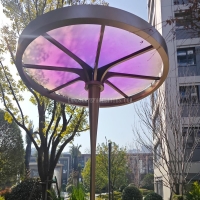Welcome to the website for landscape facilities products and knowledge.
How do landscape bar counters perform in areas with heavy rainfall or frequent storms?
Landscape bar counters have become increasingly popular for outdoor entertainment spaces, but their performance in areas with heavy rainfall or frequent storms raises important considerations for homeowners and designers. These outdoor installations can indeed withstand challenging weather conditions when properly designed and constructed using appropriate materials and techniques.
The key to weather resistance lies in material selection. Stainless steel, teak, ipe wood, and marine-grade polymer materials offer exceptional durability against moisture and extreme weather. These materials resist warping, rotting, and corrosion that typically plague outdoor structures in wet environments. Powder-coated aluminum frames provide additional protection against rust while maintaining structural integrity during high winds.
Proper drainage systems represent another critical factor for bar counters in rainy climates. Incorporating slight slopes (approximately 1-2% grade) in the counter surface prevents water accumulation. Strategic placement of drainage channels and discreet gaps between decking boards allows water to flow away efficiently rather than pooling on surfaces. Integrated gutter systems can be incorporated into the design to direct water away from both the structure and surrounding areas.
Construction techniques significantly impact storm resilience. Waterproof joinery methods, including marine-grade adhesives and stainless steel fasteners, prevent water infiltration at connection points. Elevated designs that raise the structure slightly above ground level protect against flooding and improve air circulation for faster drying. For extreme weather regions, optional removable panels or covers provide additional protection during severe storms.
Electrical components require special attention in wet conditions. All outlets, lighting, and appliances must meet wet-rated specifications with proper GFCI protection. Conduit systems should be completely waterproof, and wiring must be elevated above potential flood levels. Many designers recommend placing electrical components under covered sections or using removable power modules that can be stored during storms.
Maintenance practices greatly enhance longevity in rainy climates. Regular sealing of natural stone surfaces, reapplying protective coatings to metals, and cleaning drainage systems prevent weather-related deterioration. Seasonal inspections for cracks, sealant failures, or structural weaknesses allow for proactive repairs before minor issues become significant problems.
Despite these challenges, landscape bar counters in rainy regions offer unexpected advantages. The abundant natural rainfall simplifies cleaning routines, while the frequent cloud cover often extends comfortable outdoor usage times by reducing direct sunlight exposure. Properly designed counters actually benefit from occasional rainfall, which helps maintain ideal humidity levels for certain materials like teak wood.
Modern innovations continue to improve weather resistance. Composite materials that mimic natural wood without maintenance requirements, integrated heating systems for faster drying, and smart covers that automatically deploy during rainfall make contemporary bar counters increasingly suitable for storm-prone areas. These advancements allow homeowners in even the rainiest climates to enjoy functional outdoor entertainment spaces year-round.
The performance of landscape bar counters in wet conditions ultimately depends on intelligent design choices rather than geographical limitations. By selecting appropriate materials, incorporating effective drainage, and maintaining protective measures, these structures can provide decades of reliable service regardless of rainfall patterns or storm frequency.
Related search:

Recommendation
Metal frame with gradient color acrylic combined with high-end shading landscape facilities